 |
 |
|
 |
 |
1955-1959: Japan..JAPAN!!
Looking forward - or backwards..
While most Japanese camera producers from the 30s and upwards had been running after the West-Germans, hoping for a second place in the Leica Race, some companies in the late 40s started looking to Hungary (Gamma Duflex), East Germany (Contax,
Exakta and Praktica), Italy (Rectaflex) and Switzerland (Alpa) to understand the future. Asahi Optical made Japan's first SLR in 1952, the Asahiflex, while Orion Camera Co. made their first series produced pentaprism SLR in 1955, the Miranda. There is also
an almost unknown camera, Pentaflex, produced by Tokiwa Seiko, that was presented in 1955, four months before the Miranda. It was equipped with a penta mirror rather than a pentaprism, and was Japan's first Eye-Level SLR! I will discuss this under Tokiwa Seiki
Pentaflex. Then followed Asahi with the trendsetting Asahi Pentax in 1957, quality producer Topcon with the R and Zunow Optical with their very innovative and mythical PP SLR, named just Zunow, in 1958. It took a while for Minolta, Nikon and especially Canon
to let go of the old cameras and concentrate fully on the new trend. But when they did, they were to underline the coming of the total Japanese hegemony. This chapter includes the second wave of PP SLR development, and together with the 1948-1954-chapter,
it sums up the first 11 years of PP SLR, taking us through the 50's.
 Some Japanese veterans
Some Japanese veterans
1955: Japan: Tokiwa Seiki Pentaflex
At the front page of this site I ask my readers to correct me, as there are things to discuss. There might even be cameras that I have overseen or forgotten. Well, here is one. But no-one told me. Probably because it is so rare and hidden that no-one
knew. According to Wikipedia's "The History of Single-Lens Reflex Cameras", referring to Rudolph Lea's "The Register of 35 mm Single Lens Reflex cameras Second Ed" of 1993, the Pentaflex was a forgettable Porro prism camera. Forgettable, yes, as no-one
remembers. But Porro prism? The camera has a prism house almost exactly like the East-German Exakta. And nothing like the Porro prism of the Duflex. And the name Pentaflex more than hints towards a pentaprism/penta mirror. When studying the Porro prism
from The Hungarian Duflex, invented by Italian Ignazio Porro in 1850 and described under the Duflex chapter, the light beam hits the human eye not directly behind the lens, but to the side, in fact to the side of the prism box. On the Pentaflex, it comes out
just in the prolonged centre line of the lens. So, all facts point towards this being a pentaprism or a penta mirror.
Again, one experiences that a highly rated site like Wikipedia contains a highly rated article that refers to a highly rated
book that is most probably wrong. And site after site refers to the Wikipedia article as the truth. In this case, as in so many others. I came across this camera through a camera auction in November 2016. In fact, it was sold yesterday, November
19th. But not to me. One can only imagine the price.
Anyway, I started to investigate. The above mentioned Wikipedia article says it was released four months before the Miranda T. I have no other source telling me anything else, so let us assume
that is correct. Which leads me to the conclusion, so far, that we are talking Japan's first 35mm Pentaprism/penta mirror SLR Camera!! And thereby also Japans first eye-level SLR. Foe a definition of penta mirror, please
se Some definitions: penta mirror chapter.
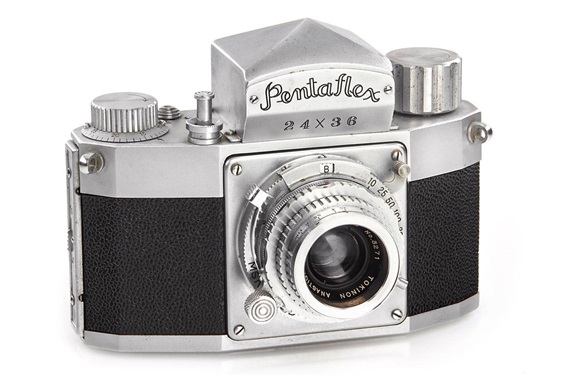 Here it is, the Tokiwa Seiki Pentaflex of spring 1955, as photographed for the auction. The prism house wears almost the exact shape of the one on the Ihagee Exakta of 1950. Tokiwa Seiki had had time to copy it. Even the writing of the name was a near copy. The prism house was put on top of the waist level camera house that was released the same year. But it was not interchangeable, as the Exakta was. Probably a penta mirror construction. If so, it has to be world's first pentamirror eye level slr camera. (And Japan's first eye level slr camera.)
Here it is, the Tokiwa Seiki Pentaflex of spring 1955, as photographed for the auction. The prism house wears almost the exact shape of the one on the Ihagee Exakta of 1950. Tokiwa Seiki had had time to copy it. Even the writing of the name was a near copy. The prism house was put on top of the waist level camera house that was released the same year. But it was not interchangeable, as the Exakta was. Probably a penta mirror construction. If so, it has to be world's first pentamirror eye level slr camera. (And Japan's first eye level slr camera.)
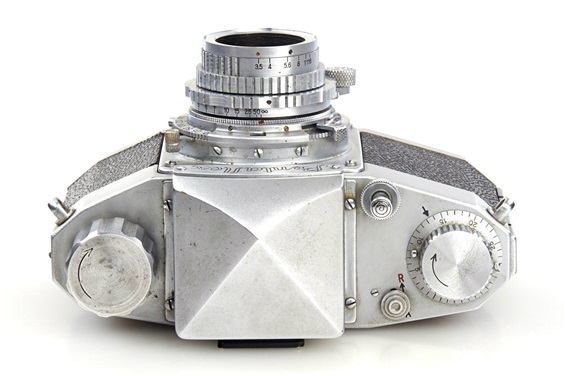 The controls: winder knob to the far right with frame counter on a dial underneath, shutter release button on the far front. And, a bit unusual, the rewind opening button, marked with the red R. No shutter time dial, as that was on the lens. To the left was only a big rewind knob.
Also note the shape of the camera house, looking very much like the Exakta.
The controls: winder knob to the far right with frame counter on a dial underneath, shutter release button on the far front. And, a bit unusual, the rewind opening button, marked with the red R. No shutter time dial, as that was on the lens. To the left was only a big rewind knob.
Also note the shape of the camera house, looking very much like the Exakta.
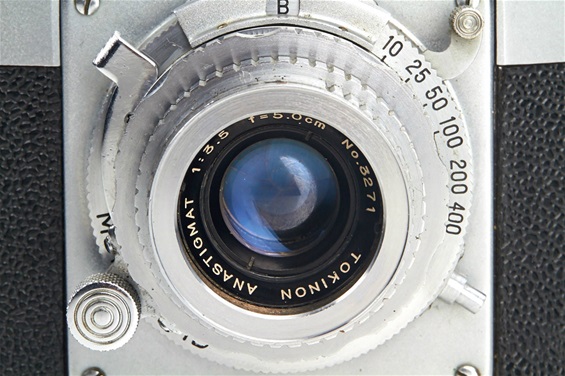 This Tokinon Anastigmat 50/3,5 lens was of central leaf shutter design, like many German and a few Japanese cameras of the 50's. The built-in shutter is an MSK Rapid. Some cameras came with Soligor Anastigmat, probably the same lens.
This Tokinon Anastigmat 50/3,5 lens was of central leaf shutter design, like many German and a few Japanese cameras of the 50's. The built-in shutter is an MSK Rapid. Some cameras came with Soligor Anastigmat, probably the same lens.
1955: Japan: Orion Camera Co. Miranda T:
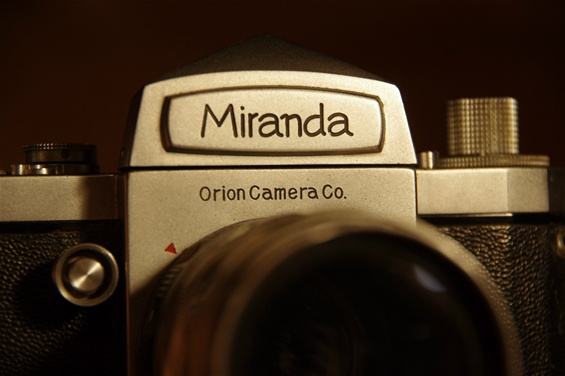 The Orion Camera Co. made Japans first pentaprism SLR in 1955, the Miranda. One year later, they changed the company name to Miranda Camera Co. My sample is an Orion from 1955. Size: 147x93x45mm. Sn: 554845. A very low number.
More about Miranda on Lost Brands: The 70s.
The Orion Camera Co. made Japans first pentaprism SLR in 1955, the Miranda. One year later, they changed the company name to Miranda Camera Co. My sample is an Orion from 1955. Size: 147x93x45mm. Sn: 554845. A very low number.
More about Miranda on Lost Brands: The 70s.
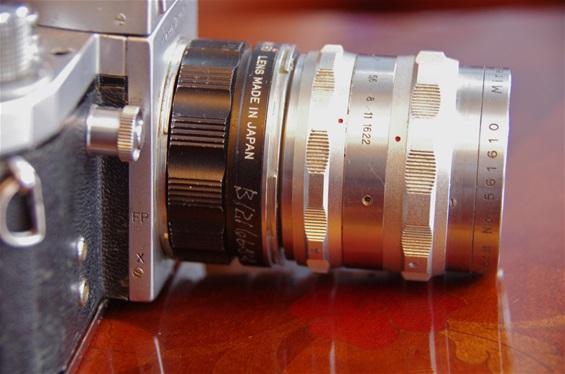 Miranda Supreme 105/2,8. Coupled to a teleconverter. Lens sn: 561610. Orion Seiki produced Supreme lenses before Miranda cameras, but obviously continued till late 50s.Still, this is a rare combination. More under : Lost Brands: Miranda.
Miranda Supreme 105/2,8. Coupled to a teleconverter. Lens sn: 561610. Orion Seiki produced Supreme lenses before Miranda cameras, but obviously continued till late 50s.Still, this is a rare combination. More under : Lost Brands: Miranda.
 Interchangeable finder - prism for eye level or open for waist level. Choice between short or long shutter times on handle outside the dial. Shutter release button on front wall in 90 degrees. Extra release button for wire release is front of the speed dial. Rewind knob and ASA setting to the left, behind the slide button for removing the finder.
Interchangeable finder - prism for eye level or open for waist level. Choice between short or long shutter times on handle outside the dial. Shutter release button on front wall in 90 degrees. Extra release button for wire release is front of the speed dial. Rewind knob and ASA setting to the left, behind the slide button for removing the finder.
1956: East Germany: Pentacon FB:
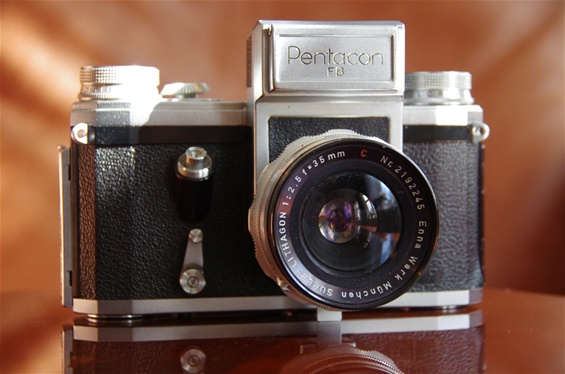 East German Contax lost the right to use the name internationally through lawsuits initiated by the West German branch of the company. The export name became Pentacon - Penta(prism) and Con(tax.) In April 1956 they launched the E-model, which lasted only till August. I do not know yet why the E-model was substituted by this FB after only four months. Anyway, the FB, as the E, came with a built-in selenium light meter, before anyone else did it. It was better than the Retina of '57 and most others with an open meter. The Contax/Pentacon nameplate would work as a shield against direct sunlight that otherwise would give false values to the meter. SN 141384.
East German Contax lost the right to use the name internationally through lawsuits initiated by the West German branch of the company. The export name became Pentacon - Penta(prism) and Con(tax.) In April 1956 they launched the E-model, which lasted only till August. I do not know yet why the E-model was substituted by this FB after only four months. Anyway, the FB, as the E, came with a built-in selenium light meter, before anyone else did it. It was better than the Retina of '57 and most others with an open meter. The Contax/Pentacon nameplate would work as a shield against direct sunlight that otherwise would give false values to the meter. SN 141384.
Flip up the shield with small button, and the selenium meter reads the light in EV.
The readings are transferred to this meter on top of the prism, giving the desired aperture value, based on given ASA and shutter time.
1957: Japan: Asahi Pentax:
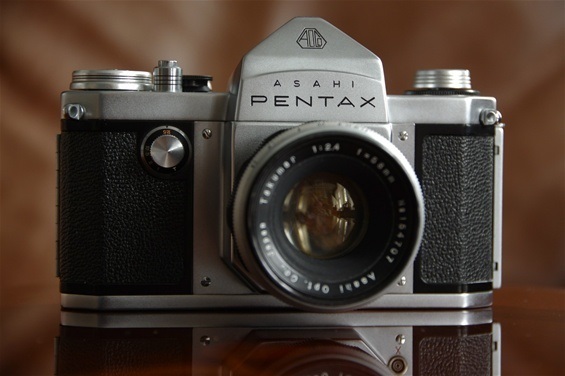 Asahi was looking forward. They never produced a rangefinder camera, but looked to the exciting development in East Germany, in particular. From the experiences they had with the Asahiflex from 1951 till 1956, they presented the camera that should be the example of how a modern camera should look. This was in April/May 1957. The first Pentax was produced in a number of 19.600. The Asahi Pentax featured the Instant Return Mirror that had its first worldwide success with the Asahiflex IIb in 1954, although it was first seen on the Hungarion Duflex in 1949. Besides it launched the microprism focusing glass, making the subject brighter and thereby easier to focus on. Also a worlds first: the foldable rewind crank.
Size: 143x92x50. Weight: 570 gr. Sn.: 144172 carrying the Takumar 58/2,4 lens with sn. 154707.
Asahi was looking forward. They never produced a rangefinder camera, but looked to the exciting development in East Germany, in particular. From the experiences they had with the Asahiflex from 1951 till 1956, they presented the camera that should be the example of how a modern camera should look. This was in April/May 1957. The first Pentax was produced in a number of 19.600. The Asahi Pentax featured the Instant Return Mirror that had its first worldwide success with the Asahiflex IIb in 1954, although it was first seen on the Hungarion Duflex in 1949. Besides it launched the microprism focusing glass, making the subject brighter and thereby easier to focus on. Also a worlds first: the foldable rewind crank.
Size: 143x92x50. Weight: 570 gr. Sn.: 144172 carrying the Takumar 58/2,4 lens with sn. 154707.
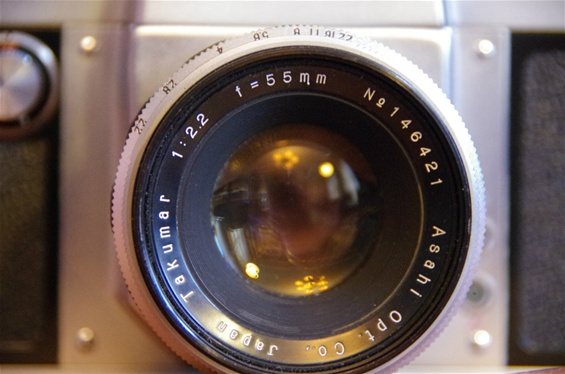 Original Takumar 55/2,2. Manual operation with preset aperture and double ring for focusing at full opening. Sn: 146421.
Original Takumar 55/2,2. Manual operation with preset aperture and double ring for focusing at full opening. Sn: 146421.
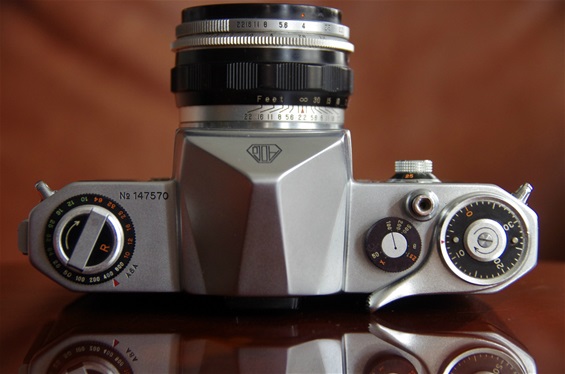 This is how almost all PP SLRs should look like for the coming 20 years or so. To the right: fast winder arm, no wheel or knob. Shutter relese button on top plate, shutter time setting dial closer to the prism. To the left: ASA setting and the unique foldable rewind crank. The dial on the front wall was for slow speed setting, and was soon to disappear. Sn on this one: 147570.
This is how almost all PP SLRs should look like for the coming 20 years or so. To the right: fast winder arm, no wheel or knob. Shutter relese button on top plate, shutter time setting dial closer to the prism. To the left: ASA setting and the unique foldable rewind crank. The dial on the front wall was for slow speed setting, and was soon to disappear. Sn on this one: 147570.
Worlds first: the foldable rewind crank. No more knobs.
Simple and easy! And much faster.
The slow shutter time dial on the front.
1957: West Germany: Kodak Retina Reflex:
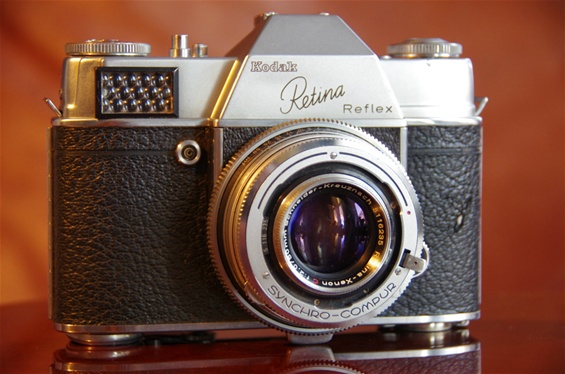 Kodak produced the Retina cameras in West-Germany and released their first PP SLR in 1957. This model, with later versions, was produced until 1968 in a number of nearly one million. Note: this first model did not have interchangeable lens. That came with the S model in '59.Size: 137x104x42mm (camera house). Weight: 858 with lens. Sn 85260.
Kodak produced the Retina cameras in West-Germany and released their first PP SLR in 1957. This model, with later versions, was produced until 1968 in a number of nearly one million. Note: this first model did not have interchangeable lens. That came with the S model in '59.Size: 137x104x42mm (camera house). Weight: 858 with lens. Sn 85260.
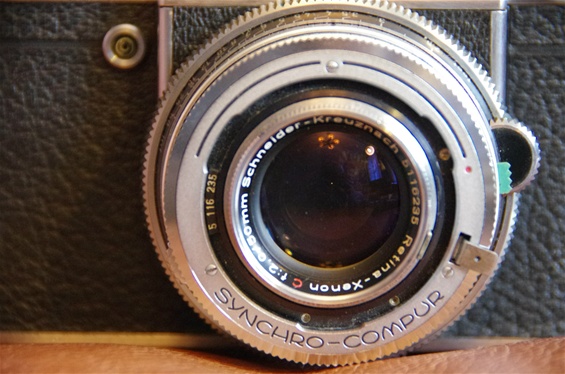 Synchro-Compur leaf shutter in the lens, not uncommon in West-German cameras from this period. Schneider-Kreuznach Retina-Xenon 50/2. Sn. 5116235.
Synchro-Compur leaf shutter in the lens, not uncommon in West-German cameras from this period. Schneider-Kreuznach Retina-Xenon 50/2. Sn. 5116235.
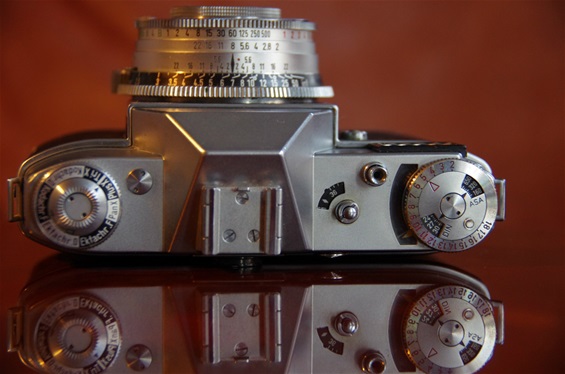 ASA/DIN setting on the dial to the right , together with an EV scale from 2 to 18. Reading of values(from selenium meter in the front) in a window along the dial where two arrows will meet when you turn the EV dial. Read the given number and adjust the EV ring on the lens accordingly. Then the given mix of aperture/shutter speed can be chosen. Simple? No. One can understand why other camera makers found other solutions.
ASA/DIN setting on the dial to the right , together with an EV scale from 2 to 18. Reading of values(from selenium meter in the front) in a window along the dial where two arrows will meet when you turn the EV dial. Read the given number and adjust the EV ring on the lens accordingly. Then the given mix of aperture/shutter speed can be chosen. Simple? No. One can understand why other camera makers found other solutions.
Adjustable EV dial to par the light meter needle.
Choose given cominations.
Overcrowded on top plate, so the winder is placed at the base plate.
1957: Japan: Tokyo Kogaku Topcon R:
 The number three Japanese pentaprism SLR, Topcon R. From day one, Topcon based their strategy on high end sturdy and innovative quality cameras that would last. Note the green shutter button on the lens wing, connected to the aperture in the lens. To be able to focus at full opening one had to push the silver handle under the N in Topcon. A system first introduced by Ihagee Exakta in '54. Size: 156x98x50mm. Sn. 159955.
The number three Japanese pentaprism SLR, Topcon R. From day one, Topcon based their strategy on high end sturdy and innovative quality cameras that would last. Note the green shutter button on the lens wing, connected to the aperture in the lens. To be able to focus at full opening one had to push the silver handle under the N in Topcon. A system first introduced by Ihagee Exakta in '54. Size: 156x98x50mm. Sn. 159955.
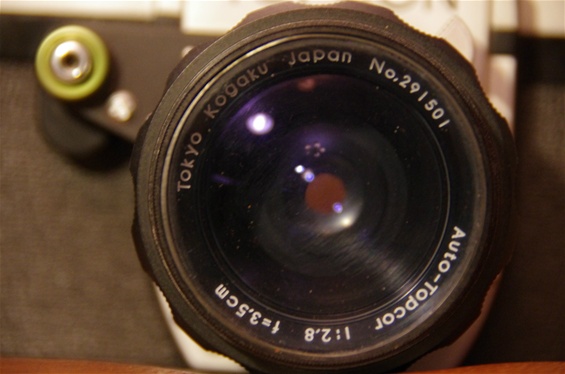 The Auto-Topcor 35/2,8. Sn. 291501.
The Auto-Topcor 35/2,8. Sn. 291501.
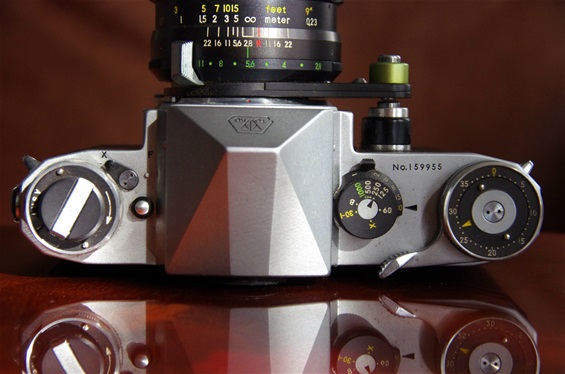 Flash F or X to be selected with a switch on top plate in stead of the usual front plate solution. Slow speed handle under high speed, like Miranda.
Flash F or X to be selected with a switch on top plate in stead of the usual front plate solution. Slow speed handle under high speed, like Miranda.
1958: Japan: Zunow:
Japanese Zunow has become a legend of early PP SLR history. Throughout the 1950s they produced very advanced lenses, among others for early Mirandas and for Leica and Nikon. In 1958 they produced a camera that was equally advanced. It was the first
slr camera to show the automatic diaphragm, and it also featured an Instant Return Mirror, as Asahi Pentax had done one year before. Unfortunately, their organization and economy was not strong, and Zunow Optical Industry Co Ltd, as was the company name, had
to give up in 1961. The cameras were only sold in Japan, and in small numbers, so they are almost impossible to find. Almost. I have come across three samples during my time of collecting. The price of two of them was as one could expect, or fear, so
they are not in my collection. However, the third one came more or less in parts, with many missing. It is presented here.
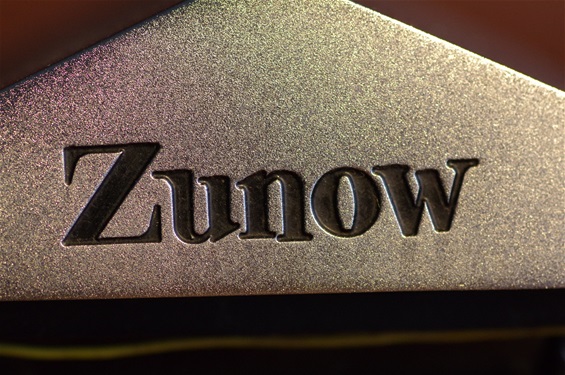 Here is the mythical logo on the front of the penta prism.
Here is the mythical logo on the front of the penta prism.
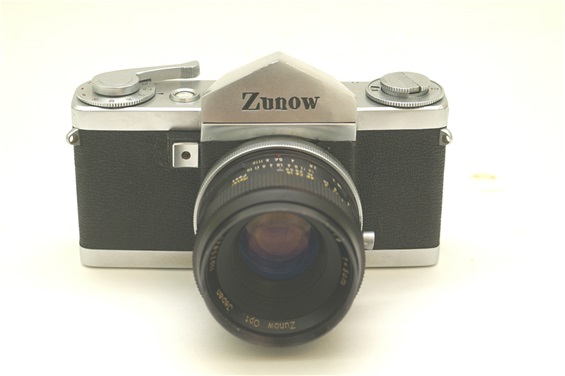 This sample is not of my collection, but this is how it looks.
This sample is not of my collection, but this is how it looks.
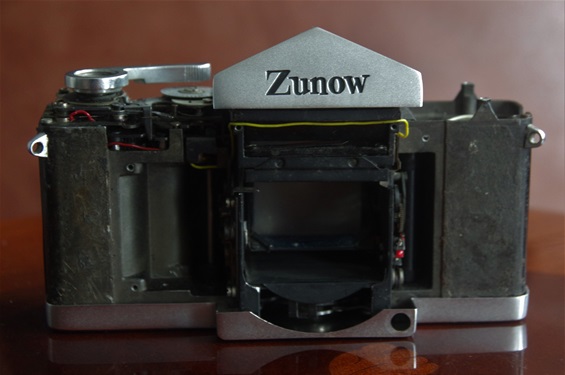 The Famous Zunow as it came - in parts, and with some central parts missing: The shutter release button on the front wall, the shutter time dial, placed under the winder, the rewind crank and the front wall with the bayonet.
The Famous Zunow as it came - in parts, and with some central parts missing: The shutter release button on the front wall, the shutter time dial, placed under the winder, the rewind crank and the front wall with the bayonet.
 The house, or most of it, the top plate, bottom plate and back wall. This is how it came. No lens, only the plastic front cap.
The house, or most of it, the top plate, bottom plate and back wall. This is how it came. No lens, only the plastic front cap.
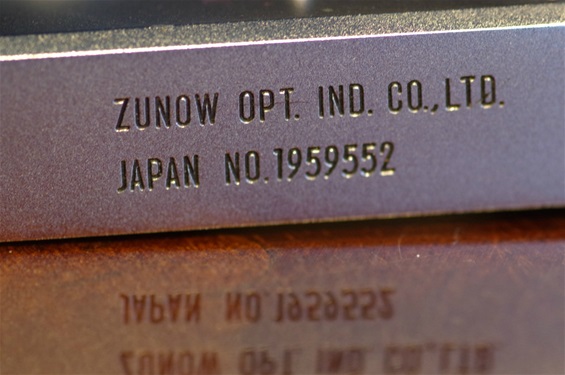 Produced in 1959. Among the last before ending the production. Probably less than 500 produced alltogether, is the usual number quoted. Well, here is one numbered 552!
Produced in 1959. Among the last before ending the production. Probably less than 500 produced alltogether, is the usual number quoted. Well, here is one numbered 552!
1958: Soviet-Union: Start:
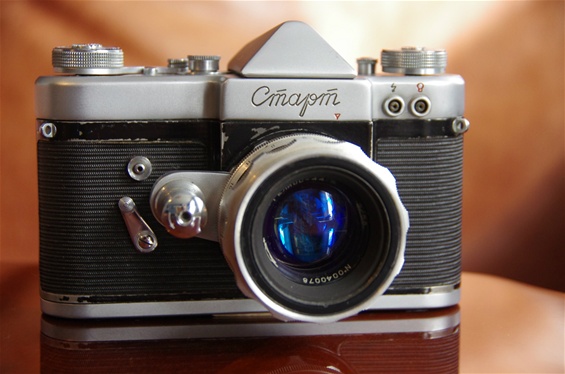 KMZ factory in Kryznogorsk outside Moscow mostly produced Zenit cameras. But in 1958 they started production of what was meant to be a soviet professional system camera. It featured interchangeable finder and a high quality lens. But only this lens was ever produced until the production was stopped in 1964. Size: 145x97x50 mm. Weight: 701 grams. Breach lock mount.
Sn. 7103433.
KMZ factory in Kryznogorsk outside Moscow mostly produced Zenit cameras. But in 1958 they started production of what was meant to be a soviet professional system camera. It featured interchangeable finder and a high quality lens. But only this lens was ever produced until the production was stopped in 1964. Size: 145x97x50 mm. Weight: 701 grams. Breach lock mount.
Sn. 7103433.
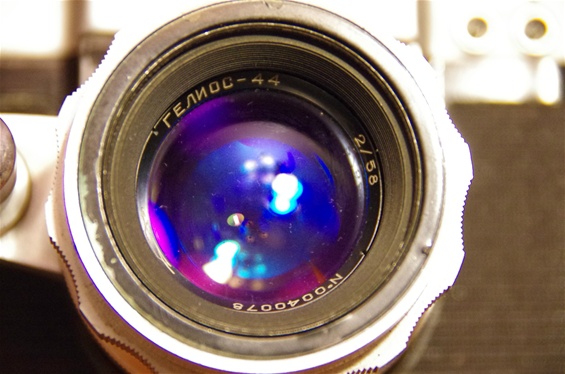 A Helios 44 58/2, as one can see. A good lens.
A Helios 44 58/2, as one can see. A good lens.
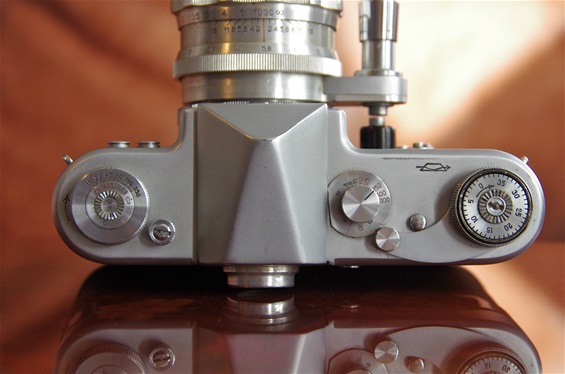 Inherited from the Exacta of 1954, followed up by Alpa, Miranda and Topcon, Start featured the PAD (Pressure Activated Diaphragm) semi automatic shutter/aperture system. The shutter is activated from a prolonged button on the lens, thus stopping down the aperture as the shutter is released. There was no IRM here, but the aperture went back to full opening after winding, which was a step ahead compared to Exakta and Topcon, for instance. And other details:
Inherited from the Exacta of 1954, followed up by Alpa, Miranda and Topcon, Start featured the PAD (Pressure Activated Diaphragm) semi automatic shutter/aperture system. The shutter is activated from a prolonged button on the lens, thus stopping down the aperture as the shutter is released. There was no IRM here, but the aperture went back to full opening after winding, which was a step ahead compared to Exakta and Topcon, for instance. And other details:
Time setting dial, winder and film counter.
Film sensitivity dial (left) and top of film cutting knife! (right)
Film cutter knife at full height.
Cutter edge at lower position.
1958: West Germany: Braun Paxette Reflex
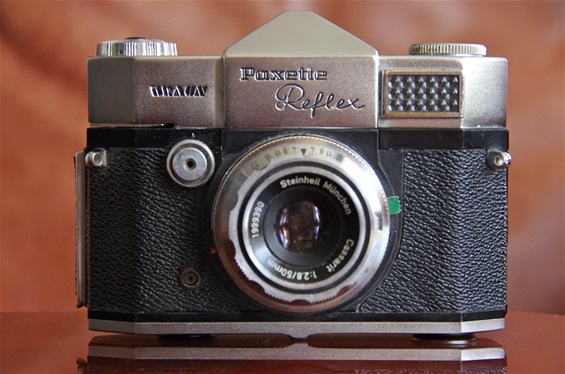 West-German company Braun came up with this Paxette Reflex in 1958. As most German brands they preferred a leaf shutter inside the lens. Most others delivered cameras with shutters in the camera, thus making it easier and less expensive to produce a variety of lenses. The number of leaf shutter lenses for these cameras was very limited, and the system died with the German brands. The Paxette Reflex was produced till 1962.
Size: 129x95x43 mm (body). Weight: 675 gr. with lens. Sn. 18731.
West-German company Braun came up with this Paxette Reflex in 1958. As most German brands they preferred a leaf shutter inside the lens. Most others delivered cameras with shutters in the camera, thus making it easier and less expensive to produce a variety of lenses. The number of leaf shutter lenses for these cameras was very limited, and the system died with the German brands. The Paxette Reflex was produced till 1962.
Size: 129x95x43 mm (body). Weight: 675 gr. with lens. Sn. 18731.
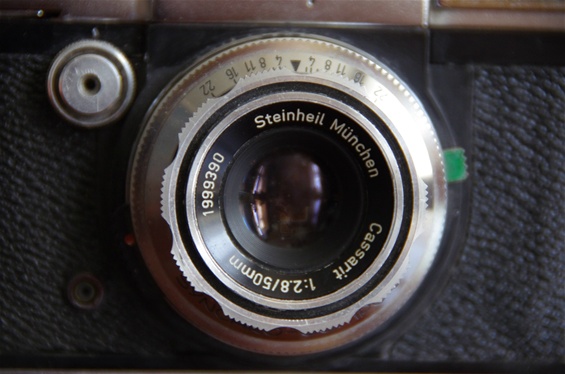 The Steinheil Cassarit 50/2,8 lens. Sn. 1999390.
The Steinheil Cassarit 50/2,8 lens. Sn. 1999390.
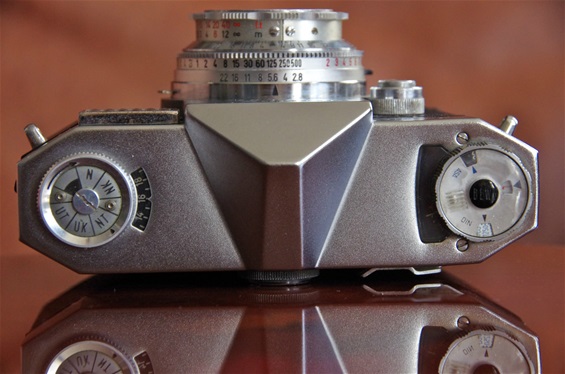 Light was measured through a selenium meter at the front, giving values in the black window to the right. By turning the dial until two arrows were matching, the correct shutter/aperture values were obtained. Note the winder arm on the back of the camera, not on the top as was usual. When winding, the very thin arm was led through a split between the metal top and the lower leatherette part.
Light was measured through a selenium meter at the front, giving values in the black window to the right. By turning the dial until two arrows were matching, the correct shutter/aperture values were obtained. Note the winder arm on the back of the camera, not on the top as was usual. When winding, the very thin arm was led through a split between the metal top and the lower leatherette part.
1958: France: Royer Savoyflex:
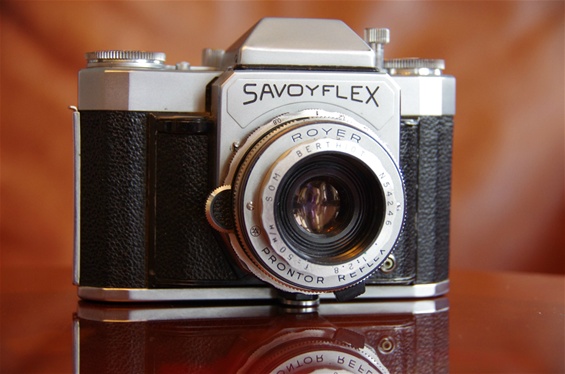 France contributed to the SLR history first with the very special Alsaflex of 1952, and in the PP SLR history from 1958 through Rene Royers Savoyflex. The first model featured a leaf shutter fixed Berthiot lens and a trigger related mirror. The mirror returned mechanically with the return of the shutter release button, and could mean that the subject, as seen through the lens, was blacked a bit longer than on the IRM cameras, where the finder was ready instantly after the shutter was shut. Many cameras claiming IRM were really TRMs. The first Savoyflex was followed by the Authomatic in 1959, the first to introduce an automatic diaphragm. The SITO organization, which was the official name behind Royer, kept on producing Savoyflex until 1963. Size measured without lens extension: 127x94x53mm. Weight with lens: 736 gr. Sn: F 1459.
France contributed to the SLR history first with the very special Alsaflex of 1952, and in the PP SLR history from 1958 through Rene Royers Savoyflex. The first model featured a leaf shutter fixed Berthiot lens and a trigger related mirror. The mirror returned mechanically with the return of the shutter release button, and could mean that the subject, as seen through the lens, was blacked a bit longer than on the IRM cameras, where the finder was ready instantly after the shutter was shut. Many cameras claiming IRM were really TRMs. The first Savoyflex was followed by the Authomatic in 1959, the first to introduce an automatic diaphragm. The SITO organization, which was the official name behind Royer, kept on producing Savoyflex until 1963. Size measured without lens extension: 127x94x53mm. Weight with lens: 736 gr. Sn: F 1459.
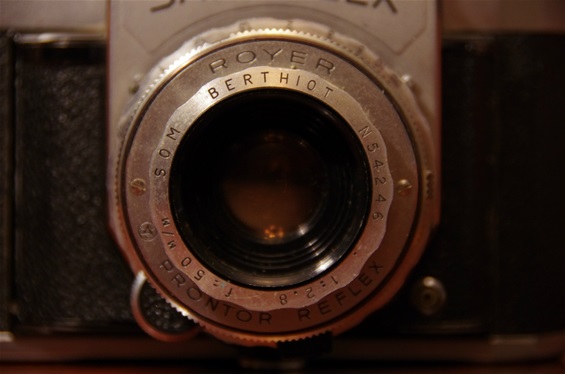 Royer Berthiot Prontor Reflex 50/2,8 leaf shutter fixed lens.
Sn: 54246.
Royer Berthiot Prontor Reflex 50/2,8 leaf shutter fixed lens.
Sn: 54246.
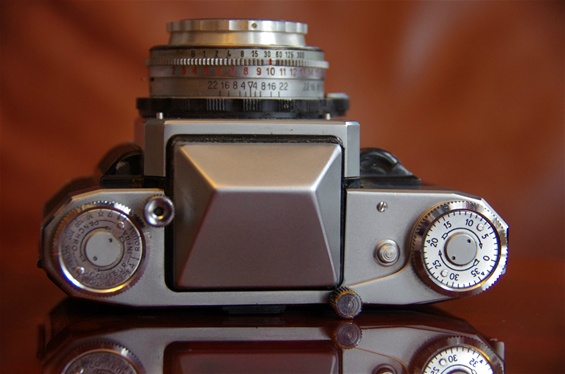 A long but wonderfully smooth winder travel. The shutter release button is to the left.
A long but wonderfully smooth winder travel. The shutter release button is to the left.
1958: Japan: Minolta SR 2:
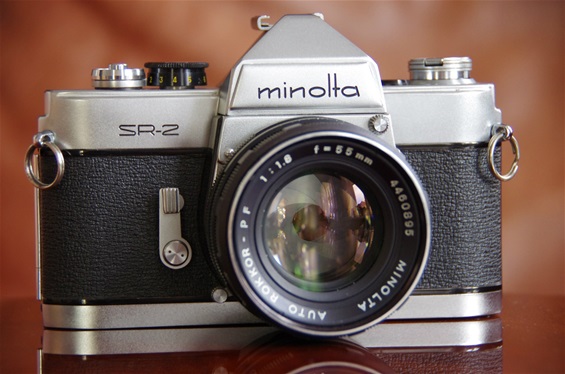 Minolta was among those who had Leica III as a leading star for too long, not being forefront in the PP SLR develpment during its first years. Still they entered the scene before Canon and Nikon, and always made quality products. Here is the rather uncommon SR 2, that, in spite of the name, came one year before the very much more available SR 1. The SR 1 was less expensive with shutter speed to 1/500, not 1/1000 as on the SR 2. Size: 144x93x52 mm. Weight: 678 grams. Proprietary mount.
Sn. 1115926.
Minolta was among those who had Leica III as a leading star for too long, not being forefront in the PP SLR develpment during its first years. Still they entered the scene before Canon and Nikon, and always made quality products. Here is the rather uncommon SR 2, that, in spite of the name, came one year before the very much more available SR 1. The SR 1 was less expensive with shutter speed to 1/500, not 1/1000 as on the SR 2. Size: 144x93x52 mm. Weight: 678 grams. Proprietary mount.
Sn. 1115926.
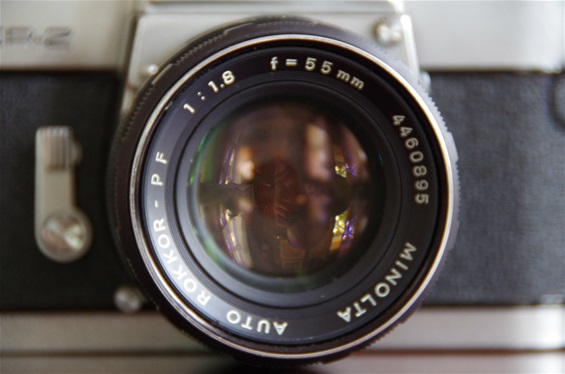 So called automatic, but in reality it was a kind of semi-automatic system where the lens opened to ful opening as the winder was cocked, like on the russian Start from the same year. Auto-Rokkor 50/1,8. Sn. 4460895.
So called automatic, but in reality it was a kind of semi-automatic system where the lens opened to ful opening as the winder was cocked, like on the russian Start from the same year. Auto-Rokkor 50/1,8. Sn. 4460895.
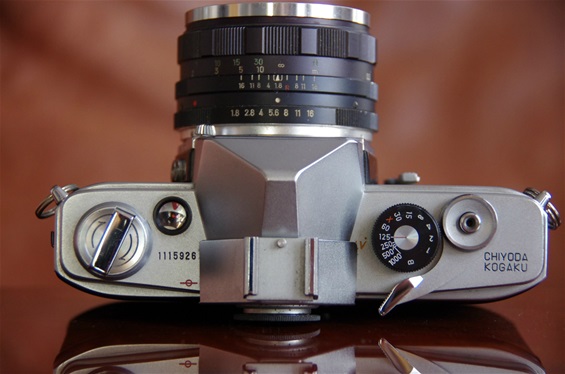 Clean layout. The winder spins around the release button.
Clean layout. The winder spins around the release button.
1958: Japan: Tokiwa Firstflex 35:
The Tokiwa Firstflex 35 penta prism slr is a very rare construction. It is also very hard to come by.
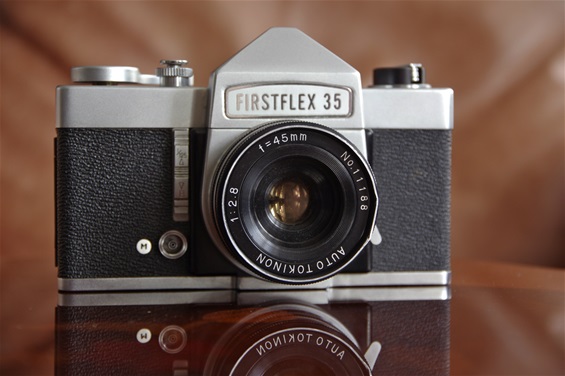 The Tokiwa Firstflex 35 was introduced in 1958, four years after Tokiwa presented their twin lens reflex with the same name. This was a remarkable construction: the mirror worked as a shutter, giving light to the film in 1/125 of a second, the only shutter time except the B! The long switch on the front panel, under the shutter release button, was to be pushed up for 1/125 and down for B. The M plug is for bulb flash. At the other side of the lens is the lens release handle, inherited from Exacta. (And Topcon.) Size: 143x91x48 mm. Weight: 654 grams.
Sn. of camera: 67417.
The Tokiwa Firstflex 35 was introduced in 1958, four years after Tokiwa presented their twin lens reflex with the same name. This was a remarkable construction: the mirror worked as a shutter, giving light to the film in 1/125 of a second, the only shutter time except the B! The long switch on the front panel, under the shutter release button, was to be pushed up for 1/125 and down for B. The M plug is for bulb flash. At the other side of the lens is the lens release handle, inherited from Exacta. (And Topcon.) Size: 143x91x48 mm. Weight: 654 grams.
Sn. of camera: 67417.
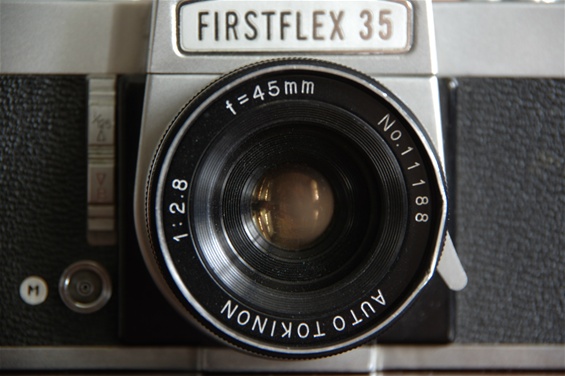 The Auto Tokinon 45/2,8 was among the few standard lenses offering a wider angle than 50mm. sn. 11188.
The Auto Tokinon 45/2,8 was among the few standard lenses offering a wider angle than 50mm. sn. 11188.
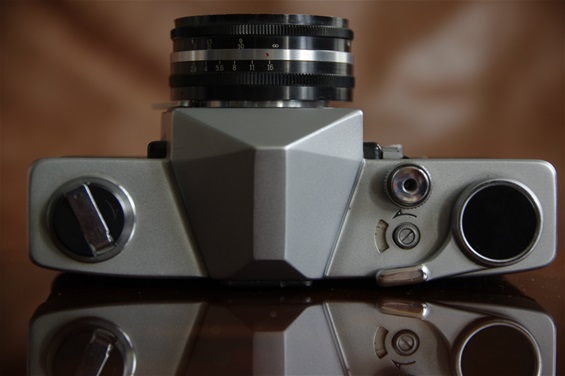 As the shutter time setting was done with the switch on the front, the lay out on the top was elegantly simple: winder arm to the right, shutter release button in front, frame counter right behind and rewind crank to the left.
The Firstflex 2, as this camera is sometimes called, after the TLR Firstflex of '54, was produced only for a short time. A third model, often seen as Plusflex, reconstructed with more shutter time options, was sold in Great Britain until the mid 60s.
As the shutter time setting was done with the switch on the front, the lay out on the top was elegantly simple: winder arm to the right, shutter release button in front, frame counter right behind and rewind crank to the left.
The Firstflex 2, as this camera is sometimes called, after the TLR Firstflex of '54, was produced only for a short time. A third model, often seen as Plusflex, reconstructed with more shutter time options, was sold in Great Britain until the mid 60s.
1958: West-Germany: Agfa Ambiflex:
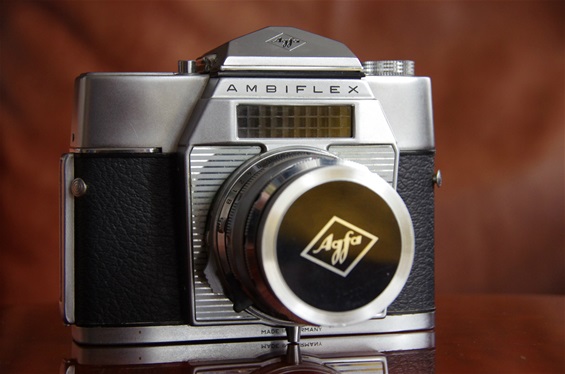 A sturdy quality camera from Agfa, sold from 1958 till 1963. Sold as Agfaflex in USA only. Size: 130x105x63mm without lens.Weight: 867 gr. Sn: AU 2331.
A sturdy quality camera from Agfa, sold from 1958 till 1963. Sold as Agfaflex in USA only. Size: 130x105x63mm without lens.Weight: 867 gr. Sn: AU 2331.
 Lens Agfa Color-Solinar 50/2,8. Interchangeable with built in leaf shutter. Sn: 425919.
Lens Agfa Color-Solinar 50/2,8. Interchangeable with built in leaf shutter. Sn: 425919.
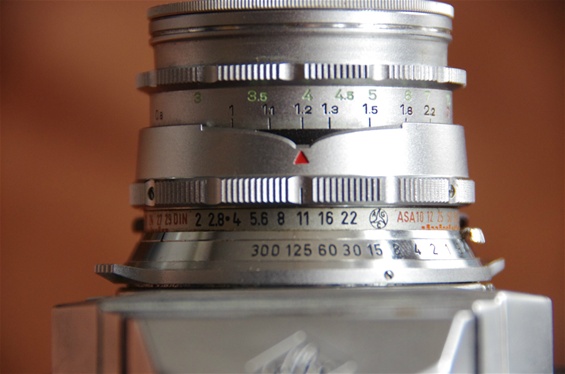 An inner ring with shutter time, next for aperture setting, those two being a part of the camera. Finally, on the lens itself, the focus ring.
An inner ring with shutter time, next for aperture setting, those two being a part of the camera. Finally, on the lens itself, the focus ring.
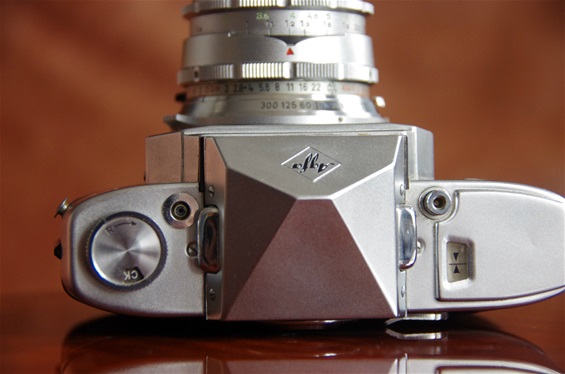 The rewinder is to the left, then a blitz contact. (German for flash.) To the right was the shutter release button and a window to view correct settings between the two arrows. On both sides of the removable prism house were two buttons to push in to release it. The winder handle on the rear wall.
The rewinder is to the left, then a blitz contact. (German for flash.) To the right was the shutter release button and a window to view correct settings between the two arrows. On both sides of the removable prism house were two buttons to push in to release it. The winder handle on the rear wall.
Counter wheel at the bottom, counting down. Winder to the top right.
1959: Japan: Canon Canonflex:
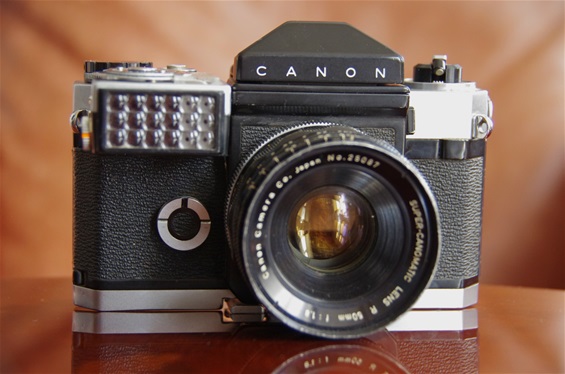 Canon had been making Leica-like range finder cameras. and good ones, too, but struggled as Asahi Pentax. Miranda, Topcon and, eventually Nikon were jumping forward with their new PP SLRs. Canons first, which actually came just before Nikon, was never a great success. With a rather clumsy design and no really new features, it lost against Nikon, Pentax and Miranda. My sample is an early one, sn. 22864. Size: 148x98x49mm.
Canon had been making Leica-like range finder cameras. and good ones, too, but struggled as Asahi Pentax. Miranda, Topcon and, eventually Nikon were jumping forward with their new PP SLRs. Canons first, which actually came just before Nikon, was never a great success. With a rather clumsy design and no really new features, it lost against Nikon, Pentax and Miranda. My sample is an early one, sn. 22864. Size: 148x98x49mm.
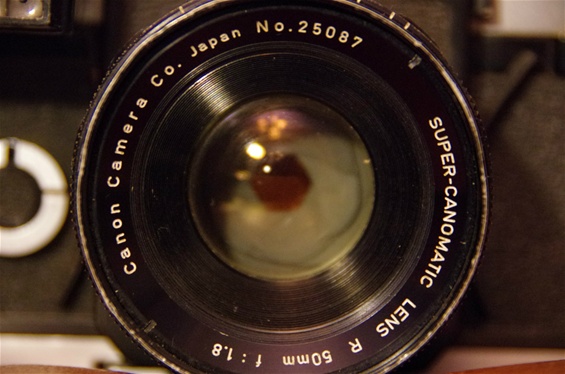 Super Canonmatic 50/1,8. Sn. 25087.
Super Canonmatic 50/1,8. Sn. 25087.
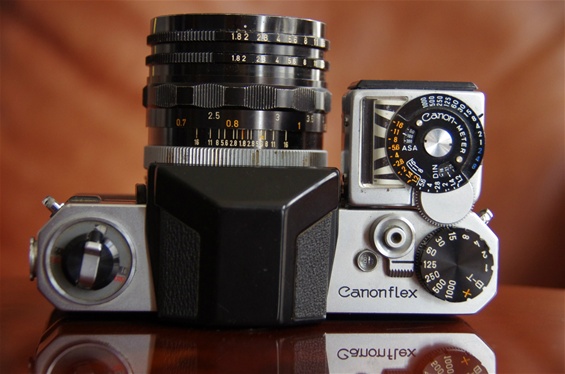 With the meter on, it was a rather big dashboard. The light sensitivity dial is directly connected to the shutter speed dial. And the winder? Under the camera, and needed to be operated with the left hand! Not fast to operate, besides, the mounting of a tripod was sometimes impossible. Strangely enough, Canon kept this for some years. They were definitely not leading at this point.
With the meter on, it was a rather big dashboard. The light sensitivity dial is directly connected to the shutter speed dial. And the winder? Under the camera, and needed to be operated with the left hand! Not fast to operate, besides, the mounting of a tripod was sometimes impossible. Strangely enough, Canon kept this for some years. They were definitely not leading at this point.
Here, under the camera, is the winder.
Flip down the end, and wind.
1959: Japan: Nikon F:
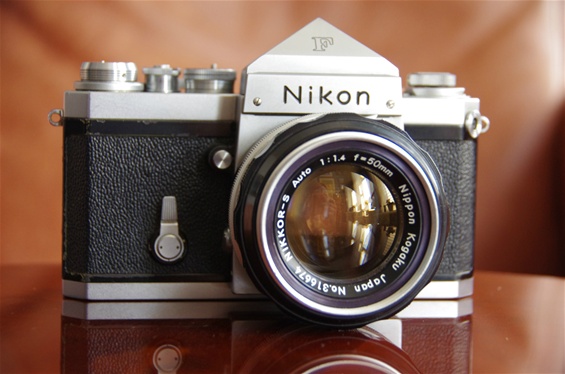 Just say the word Nikon F, and some will tremble. With this model of 1959, Nikon obtained two things: They parked Canon completely for many years to come, and they marked the end of the Leica hegemony. Nikon did not launch so many world news, but the F-series was built for professionals, with very high quality and with lots of lenses and other helpful stuff to come along.
Pictured here is my early F, the sn. 6466804. Size: 146x91x52mm.
Just say the word Nikon F, and some will tremble. With this model of 1959, Nikon obtained two things: They parked Canon completely for many years to come, and they marked the end of the Leica hegemony. Nikon did not launch so many world news, but the F-series was built for professionals, with very high quality and with lots of lenses and other helpful stuff to come along.
Pictured here is my early F, the sn. 6466804. Size: 146x91x52mm.
 Nikkor S Auto 50/1,4. Sn. 316674. With the F, Nikon launched lenses from 21 to 1000 mm.
Nikkor S Auto 50/1,4. Sn. 316674. With the F, Nikon launched lenses from 21 to 1000 mm.
The Nippon Kagaku logo on the first series.
1959: Japan: Petri Penta (Flex):
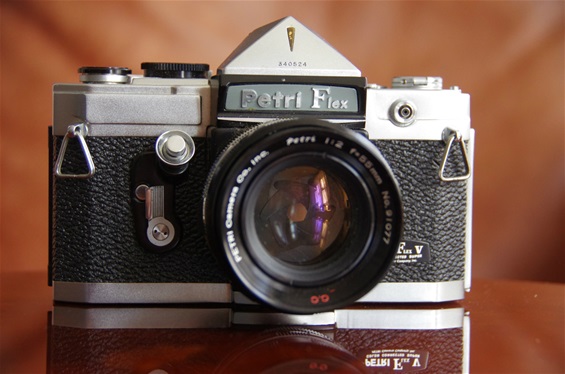 Petri Penta (Petri Flex for export) from '59 was Petris first PP SLR and Japans eighth brand to enter the scene. It was a stylish camera with some special construction details, like the camshaft shutter tensioning mechanism. Few have survived in good working condition, though. The first model came with M 42 mount, while later models introduced a Petri breech-lock bayonet mount, as on this Petri Flex V from 1961. Size: 142x93x50mm. Weight: 649 grams. Sn. 340524. For a presentation of Petri Penta from '59, see Petri 1959-1977.
Petri Penta (Petri Flex for export) from '59 was Petris first PP SLR and Japans eighth brand to enter the scene. It was a stylish camera with some special construction details, like the camshaft shutter tensioning mechanism. Few have survived in good working condition, though. The first model came with M 42 mount, while later models introduced a Petri breech-lock bayonet mount, as on this Petri Flex V from 1961. Size: 142x93x50mm. Weight: 649 grams. Sn. 340524. For a presentation of Petri Penta from '59, see Petri 1959-1977.
 Petri 55/2. Sn. 91077. A special lens mount where the inner ring is attached to the camera, as on Praktina of '53.
Petri 55/2. Sn. 91077. A special lens mount where the inner ring is attached to the camera, as on Praktina of '53.
 Traditional design to the right, but with Praktica-like shutter release in 45 degrees on the front wall. Rewind to the left, plus a switch for X or FP flash and frame counter window.
Traditional design to the right, but with Praktica-like shutter release in 45 degrees on the front wall. Rewind to the left, plus a switch for X or FP flash and frame counter window.
1959: West-Germany: Voigtlander Bessamatic:
 Voigtländer of West-Germany introduced this Bessamatic in 1959. As the other West-Germans, they were not really matching the Japanese and sold their cameras mainly in western Europe. Still no IRM (Instant Return Mirror), and like most West-German cameras at the time, it had a selenium meter for setting shutter/aperture values. From 1960, the Zoomar, worlds first zoom lens, was available. 141x103x47mm, weight:935 grams with lens. Sn: 81373.
Voigtländer of West-Germany introduced this Bessamatic in 1959. As the other West-Germans, they were not really matching the Japanese and sold their cameras mainly in western Europe. Still no IRM (Instant Return Mirror), and like most West-German cameras at the time, it had a selenium meter for setting shutter/aperture values. From 1960, the Zoomar, worlds first zoom lens, was available. 141x103x47mm, weight:935 grams with lens. Sn: 81373.
 The Bessamatic had a selenium light meter in front and an visible arrow/circle in the viewfinder. To get the correct exposure, set the shutter time on the lens, turn the big dial to the left until the arrow hits the circle and push the trigger. A simple system, not very exact, but the best at the time. The weakness being that the metering did not tell you the light values that was reflected from the subject itself. The TTL metering, presented by Asahi Pentax one year later, was the answer.
The Bessamatic had a selenium light meter in front and an visible arrow/circle in the viewfinder. To get the correct exposure, set the shutter time on the lens, turn the big dial to the left until the arrow hits the circle and push the trigger. A simple system, not very exact, but the best at the time. The weakness being that the metering did not tell you the light values that was reflected from the subject itself. The TTL metering, presented by Asahi Pentax one year later, was the answer.
1959: Japan: Aires Penta 35:
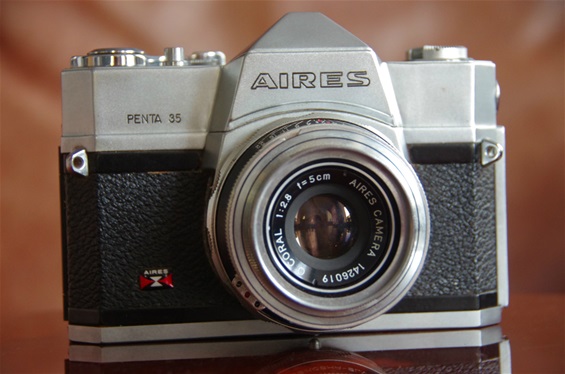 Aires was a small Japanese optical company making 35 mm rangefinder cameras throughout the fifties. In 1959, they presented a PP SLR named Penta 35. It was inspired by the West German leaf shutter cameras, but was not representing any challenge to the other Japanese brands. The lens was a fixed Q Coral 28/50. In July 1960 Aires launched a new version with a light meter, but the company went bankrupt later the same month.
Sn. 3033712.
Aires was a small Japanese optical company making 35 mm rangefinder cameras throughout the fifties. In 1959, they presented a PP SLR named Penta 35. It was inspired by the West German leaf shutter cameras, but was not representing any challenge to the other Japanese brands. The lens was a fixed Q Coral 28/50. In July 1960 Aires launched a new version with a light meter, but the company went bankrupt later the same month.
Sn. 3033712.
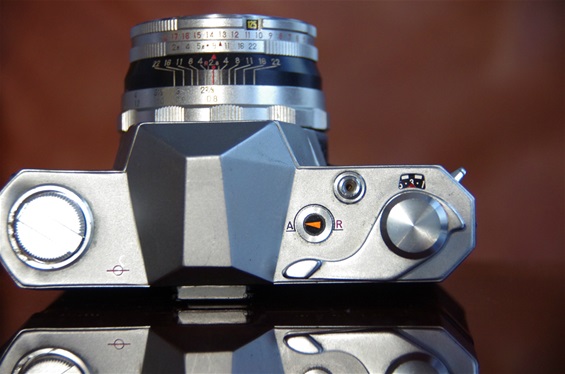 Clean, simple layout. The A/R marks the on/off switch. Shutter times are set on the front ring on the lens.
Clean, simple layout. The A/R marks the on/off switch. Shutter times are set on the front ring on the lens.
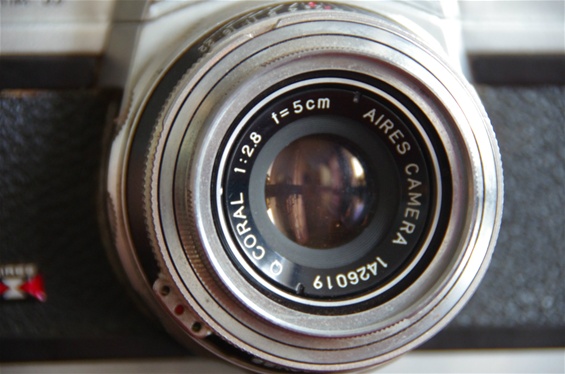 The fixed lens Aires Q Coral 50/2,8 with built in leaf shutter.
The fixed lens Aires Q Coral 50/2,8 with built in leaf shutter.
1959: England: Wrayflex II:
Wray Optical of Bromley, South London, had an approved patent from May 1947 for a special penta prism SLR. A camera, Wrayflex I was presented in 1950, but that was not a full working PP SLR. Not before 1959 were they able to present this Wrayflex IIa.
However, at that time almost all other brands had a similar or better camera on the market, and Wray produced only some 350 units before they had to close in 1961.
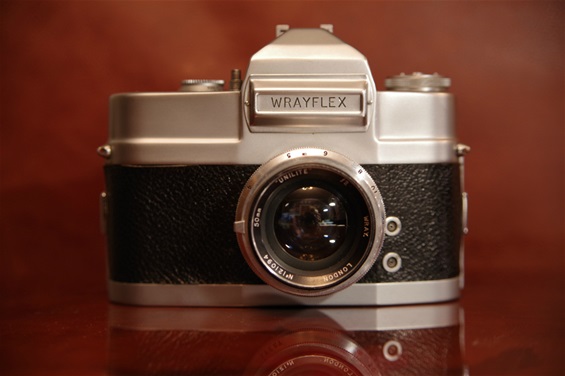 Wrayflex II of 1959, more than ten years after Wray Optical got their PP SLR patent. At this point, the leading brands offered Instant Return Mirror, some even external selen light metering. Pentax was only a bit more than a year away from showing their TTL metering and had shown the world how a modern camera should look. So, Wrayflex II was outdated upon presentation.
Size: 139x102x49 mm. Weight: 725 grams w/o lens. S.nr: 4366.
Wrayflex II of 1959, more than ten years after Wray Optical got their PP SLR patent. At this point, the leading brands offered Instant Return Mirror, some even external selen light metering. Pentax was only a bit more than a year away from showing their TTL metering and had shown the world how a modern camera should look. So, Wrayflex II was outdated upon presentation.
Size: 139x102x49 mm. Weight: 725 grams w/o lens. S.nr: 4366.
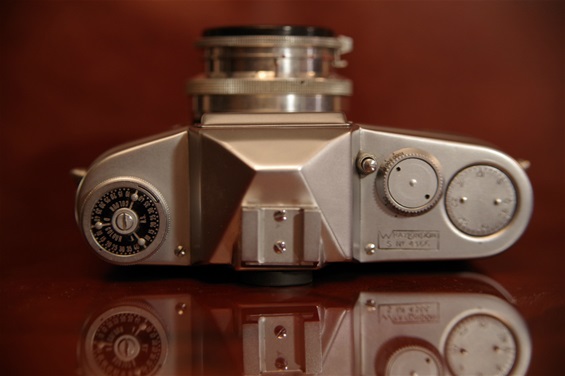 Controls: Frame counter to the right, then shutter speed dial and trigger. Flash shoe on top of prism house. To the left was the film type reminder. But where is the rewinder?
Controls: Frame counter to the right, then shutter speed dial and trigger. Flash shoe on top of prism house. To the left was the film type reminder. But where is the rewinder?
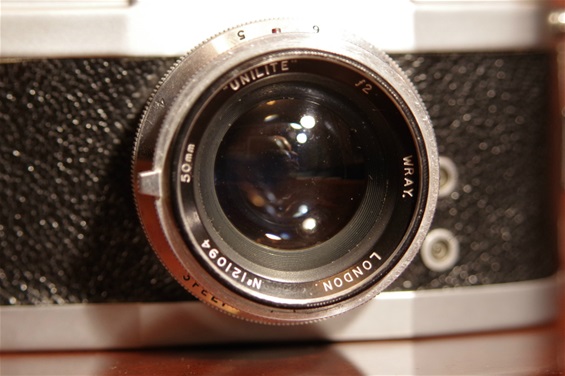 The lens was a Wray Optical Unilite 50/2. The mount was threaded and a bit wider than the M39. Aperture openings between 2 and 22. S.nr: 121094
The lens was a Wray Optical Unilite 50/2. The mount was threaded and a bit wider than the M39. Aperture openings between 2 and 22. S.nr: 121094
Logo with serial number. Frame counter.
Rewinder under the base plate!
Do you miss these?
The following PP SLR cameras were presented in this period, but not for sale: - Zeiss Ikon Contarex (West-Germany): shown 1958, production started 1959, publically accessable from March 1960. An interesting camera, but according to my definitions
it belongs to the 60s. In my collection. Zeiss Ikon: 1953-'72 -Yashica Pentamatic: Presented in 1959, for sale in 1960. In my collection. Yashica: 1960-1994
|
|
 |
|
|
|